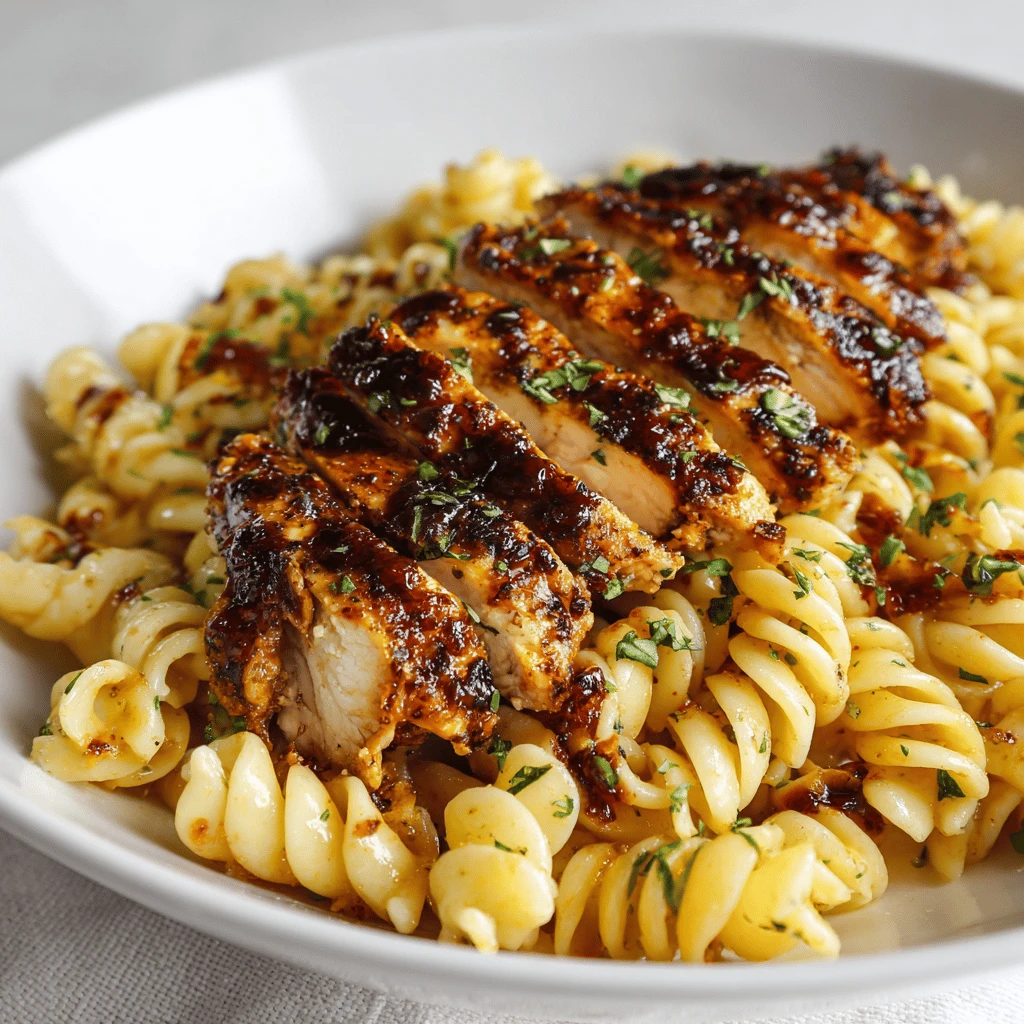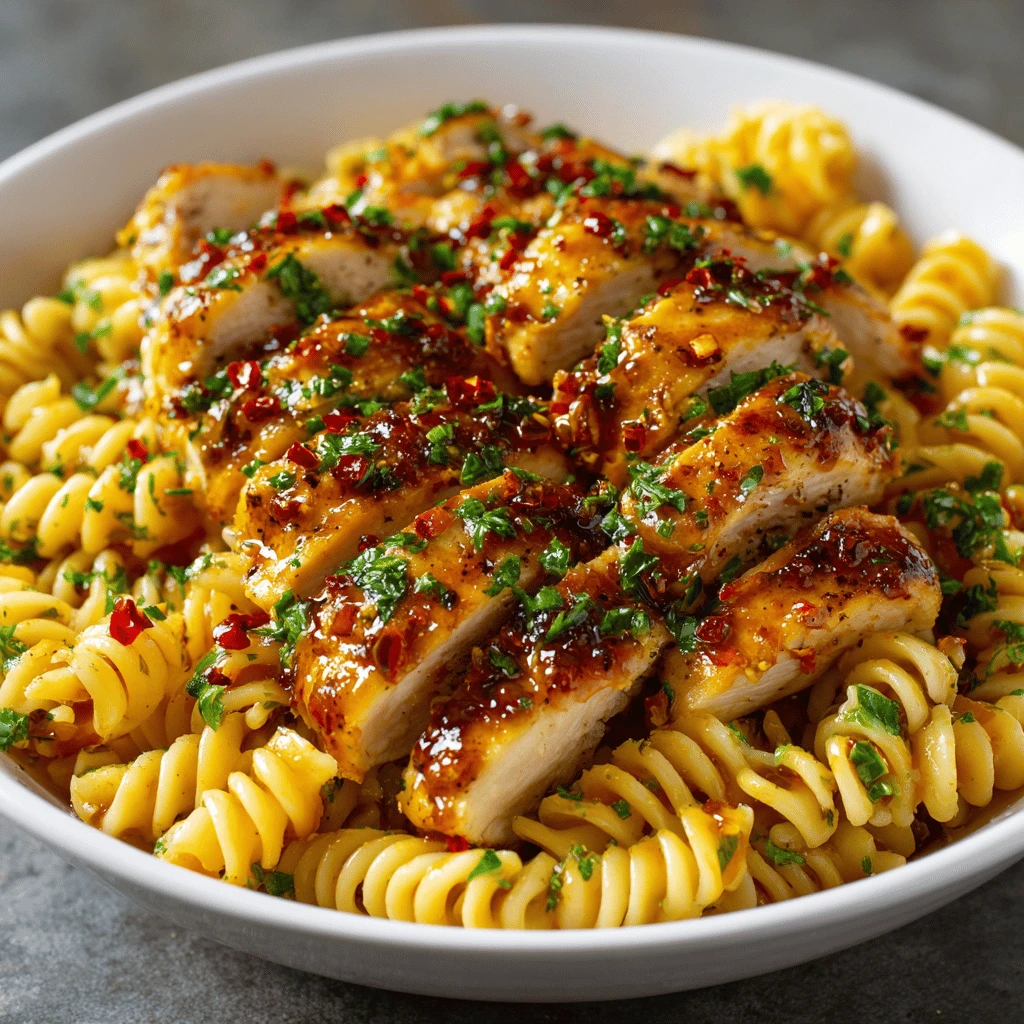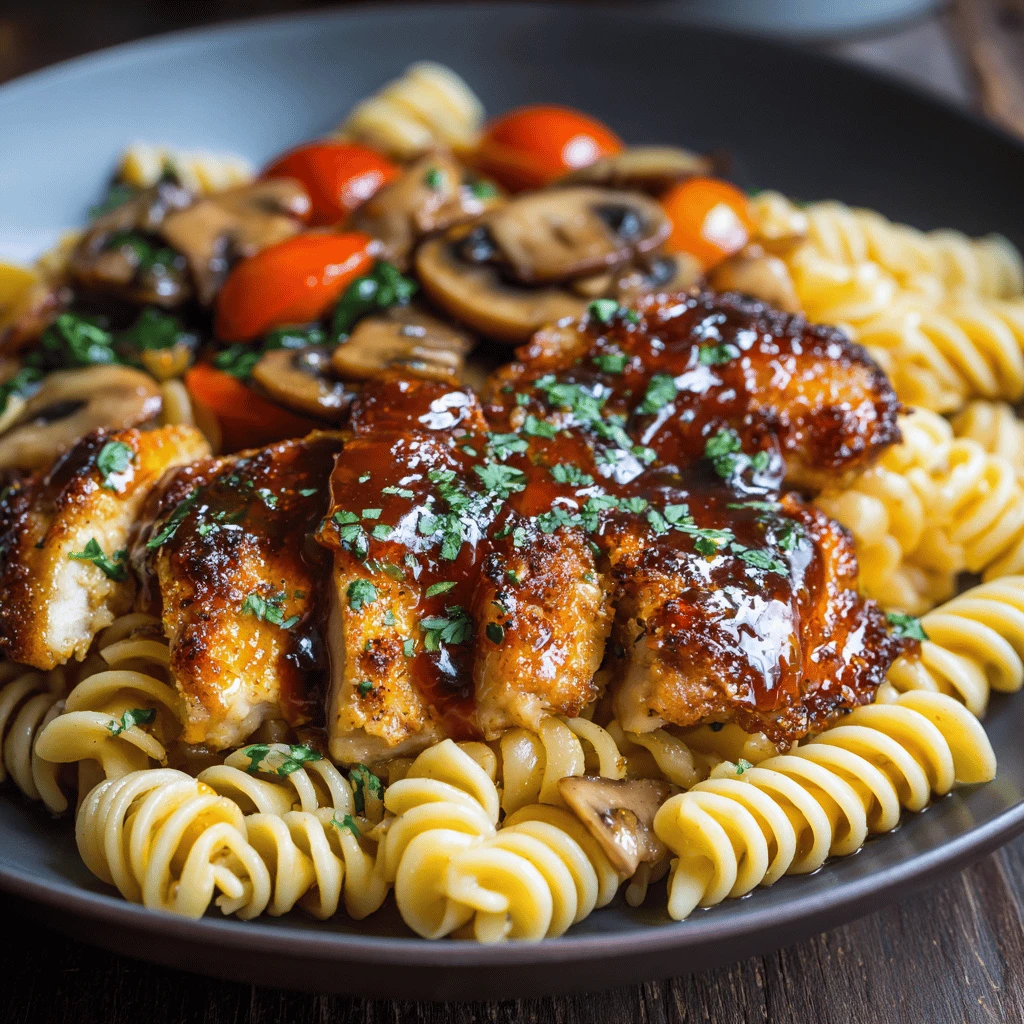Easy Glazed Chicken Breast Pasta
Glazed chicken breast pasta is a delightful and versatile dish that combines the savory goodness of chicken with the comfort of pasta, all coated in a sweet and tangy glaze. Perfect for a weeknight dinner or a casual gathering, this recipe is easy to customize and sure to please even the pickiest eaters. Let’s dive into creating a flavorful and satisfying glazed chicken breast pasta dish.
Choosing Your Ingredients for Glazed Chicken Breast Pasta
The key to a truly delicious glazed chicken breast pasta lies in selecting high-quality ingredients. Here’s a breakdown of the essentials:
Chicken Breast: Opt for boneless, skinless chicken breasts. They cook evenly and are easy to slice or cube for incorporating into the pasta. Look for breasts that are plump and have a healthy pink color.
Pasta: The type of pasta you choose will impact the overall texture and presentation of the dish. Penne, rotini, farfalle (bow tie), and fusilli all work well because their shapes hold the glaze nicely. Spaghetti or linguine are also options, but the glaze might not cling as effectively. Consider whole wheat pasta for added fiber.
Glaze Ingredients: This is where you can get creative. A common base involves honey, soy sauce, and some form of acid, such as rice vinegar or lemon juice. Other flavorful additions include garlic, ginger, sriracha, brown sugar, and sesame oil. Adjust the proportions to achieve your desired level of sweetness, tanginess, and spiciness.
Vegetables (Optional): Adding vegetables not only enhances the nutritional value but also contributes to the overall flavor profile. Broccoli, bell peppers, onions, asparagus, mushrooms, and peas are all excellent choices. Consider roasting or sautéing them beforehand to bring out their natural sweetness.
Garnish: Fresh herbs like parsley, cilantro, or green onions add a pop of color and freshness. Toasted sesame seeds also provide a pleasant crunch and nutty flavor. A sprinkle of red pepper flakes can add a touch of heat.
Preparing the Glazed Chicken and Pasta
Proper preparation is crucial for achieving the best results. Follow these steps for perfectly cooked chicken and pasta:
Cooking the Chicken:
1. Pound the Chicken (Optional): If your chicken breasts are thick, pound them to an even thickness (about 1/2 inch) to ensure they cook evenly. Place the chicken between two sheets of plastic wrap and use a meat mallet or rolling pin to gently flatten it.
2. Season the Chicken: Season the chicken breasts generously with salt, pepper, garlic powder, and onion powder. You can also add a pinch of paprika or chili powder for extra flavor.
3. Cook the Chicken: There are several ways to cook the chicken:
Pan-Seared: Heat olive oil or sesame oil in a large skillet over medium-high heat. Add the chicken breasts and cook for 5-7 minutes per side, or until cooked through and the internal temperature reaches 165°F (74°C).
Baked: Preheat your oven to 400°F (200°C). Place the seasoned chicken breasts on a baking sheet lined with parchment paper. Bake for 20-25 minutes, or until cooked through.
Grilled: Preheat your grill to medium-high heat. Grill the chicken breasts for 5-7 minutes per side, or until cooked through.
4. Rest the Chicken: Once cooked, let the chicken rest for 5-10 minutes before slicing or cubing it. This allows the juices to redistribute, resulting in more tender and flavorful chicken.
Cooking the Pasta:
1. Boil Water: Fill a large pot with salted water and bring it to a rolling boil.
2. Add Pasta: Add the pasta to the boiling water and cook according to the package directions, until al dente (firm to the bite).
3. Drain and Rinse (Optional): Drain the pasta in a colander. Rinsing the pasta with cold water can help prevent it from sticking together, but it’s not always necessary, especially if you’re adding it directly to the sauce.
Making the Glaze and Assembling the Dish
The glaze is the heart of this dish, infusing the chicken and pasta with its irresistible flavor. Here’s how to make it and bring everything together:
Making the Glaze:
1. Combine Ingredients: In a small saucepan, whisk together the glaze ingredients. A basic glaze might include honey, soy sauce, rice vinegar (or lemon juice), minced garlic, grated ginger, and a pinch of red pepper flakes.
2. Simmer the Glaze: Bring the glaze to a simmer over medium heat. Cook for 5-7 minutes, or until the glaze has thickened slightly. Be careful not to burn it. You want it to coat the back of a spoon.
3. Adjust the Flavor: Taste the glaze and adjust the seasoning as needed. Add more honey for sweetness, soy sauce for saltiness, vinegar for tanginess, or red pepper flakes for heat.
Assembling the Dish:
1. Combine Pasta and Glaze: In a large bowl, combine the cooked pasta with the glaze. Toss to coat evenly.
2. Add Chicken and Vegetables: Add the sliced or cubed chicken and any cooked vegetables to the pasta. Toss gently to combine.
3. Serve Immediately: Serve the glazed chicken breast pasta immediately, garnished with fresh herbs and sesame seeds.
Tips for a Perfect Glaze:
- Consistency is Key: The glaze should be thick enough to coat the chicken and pasta without being too sticky.
- Sweet and Savory Balance: Experiment with the proportions of sweet and savory ingredients to achieve your desired flavor profile.
- Don’t Overcook: Overcooking the glaze can result in a burnt or bitter taste. Keep a close eye on it while it simmers.
Variations and Customization
One of the best things about this glazed chicken breast pasta recipe is its versatility. Here are some ideas for variations and customizations:
Spice It Up: Add a generous pinch of red pepper flakes, a dash of sriracha, or a finely chopped chili pepper to the glaze for extra heat.
Make It Creamy: Stir in a splash of heavy cream or coconut milk to the glaze for a richer and creamier sauce.
Add Cheese: Sprinkle grated Parmesan cheese, mozzarella cheese, or crumbled feta cheese over the finished dish for added flavor and texture.
Use Different Proteins: Substitute the chicken breast with shrimp, tofu, or pork tenderloin.
Make it Vegetarian: Omit the chicken and add extra vegetables, or use plant-based protein like tempeh or chickpeas.
Different Pasta Types: Try different pasta shapes such as rigatoni, orecchiette, or even Asian noodles like udon or soba.
Fruit Additions: Add chunks of pineapple or mandarin oranges for a sweet and tangy twist.
Nutty Flavors: Add chopped peanuts or cashews for a crunchy texture and nutty flavor.
Wine Pairing: A crisp white wine like Pinot Grigio or Sauvignon Blanc pairs well with glazed chicken breast pasta.
Serving and Storing Glazed Chicken Breast Pasta
This dish is best served immediately while the pasta is still warm and the glaze is glossy. However, leftovers can be stored in the refrigerator for up to 3 days.
Serving Suggestions:
- Serve with a side salad or steamed vegetables for a complete meal.
- Garnish with fresh herbs and toasted sesame seeds for added flavor and visual appeal.
- Offer a variety of toppings, such as red pepper flakes, grated cheese, or chopped nuts, so guests can customize their own portions.
Storing Leftovers:
- Store leftover glazed chicken breast pasta in an airtight container in the refrigerator.
- Reheat in the microwave or in a skillet over medium heat until heated through.
- Add a splash of water or broth to the skillet to prevent the pasta from drying out.
Make-Ahead Tips:
- You can prepare the glaze ahead of time and store it in the refrigerator for up to 3 days.
- Cook the chicken and pasta separately and store them in the refrigerator until ready to assemble the dish.
- When ready to serve, simply reheat the chicken and pasta, combine them with the glaze, and toss to coat.
Frequently Asked Questions
Can I use chicken thighs instead of chicken breasts?
Yes, you can use boneless, skinless chicken thighs as a substitute for chicken breasts. They may require a slightly longer cooking time to reach an internal temperature of 165°F (74°C).
Can I make this dish gluten-free?
Yes, you can easily make this dish gluten-free by using gluten-free pasta and gluten-free soy sauce (tamari).
Can I freeze glazed chicken breast pasta?
While technically you can freeze it, the pasta texture can change upon thawing. It’s best enjoyed fresh or within a few days of making. If freezing, consider slightly undercooking the pasta initially.
How can I prevent the pasta from sticking together?
Rinsing the cooked pasta with cold water can help prevent it from sticking together. You can also toss the pasta with a little bit of olive oil before adding it to the glaze.
What other vegetables can I add?
The possibilities are endless! Some other vegetables that would work well include zucchini, eggplant, snap peas, and corn.




